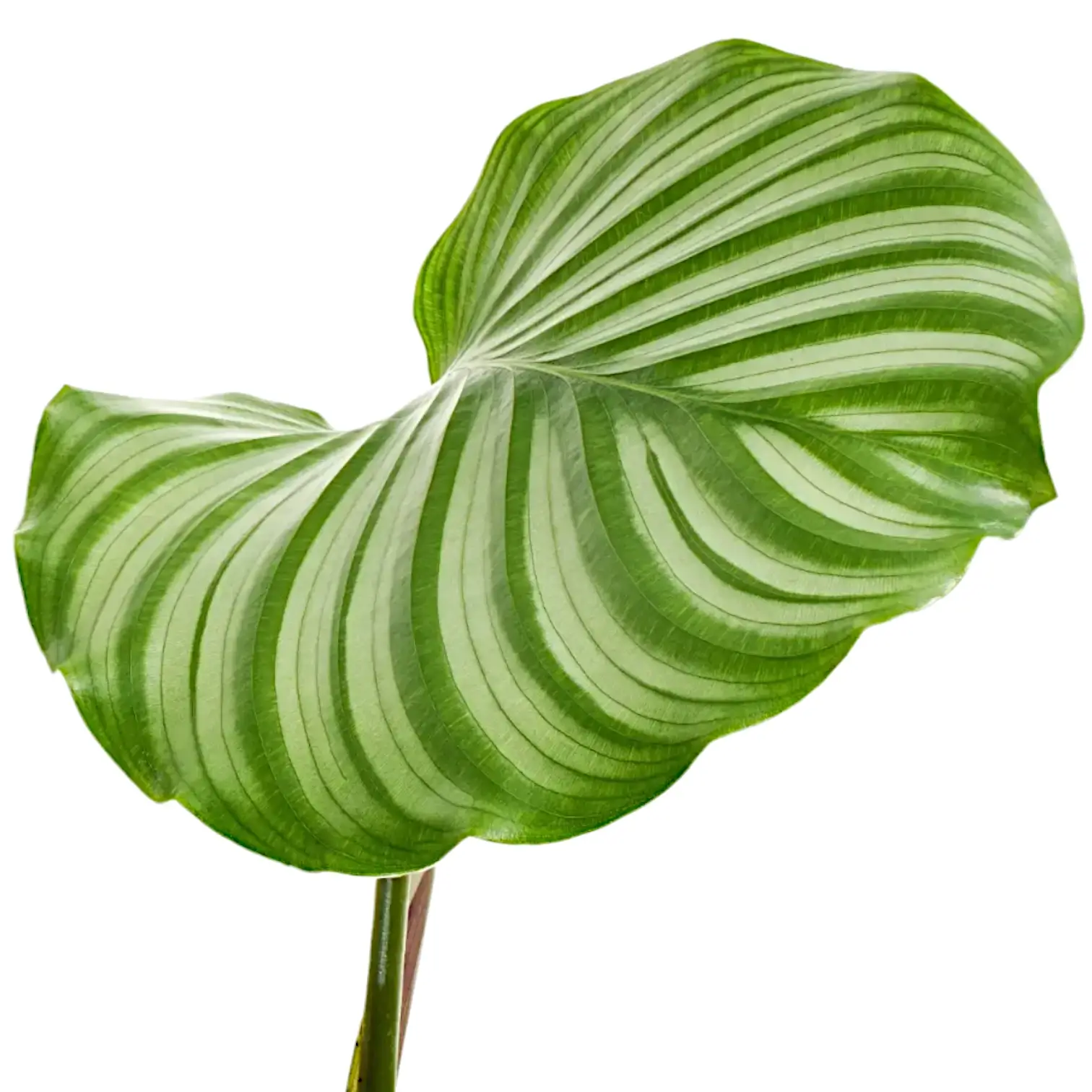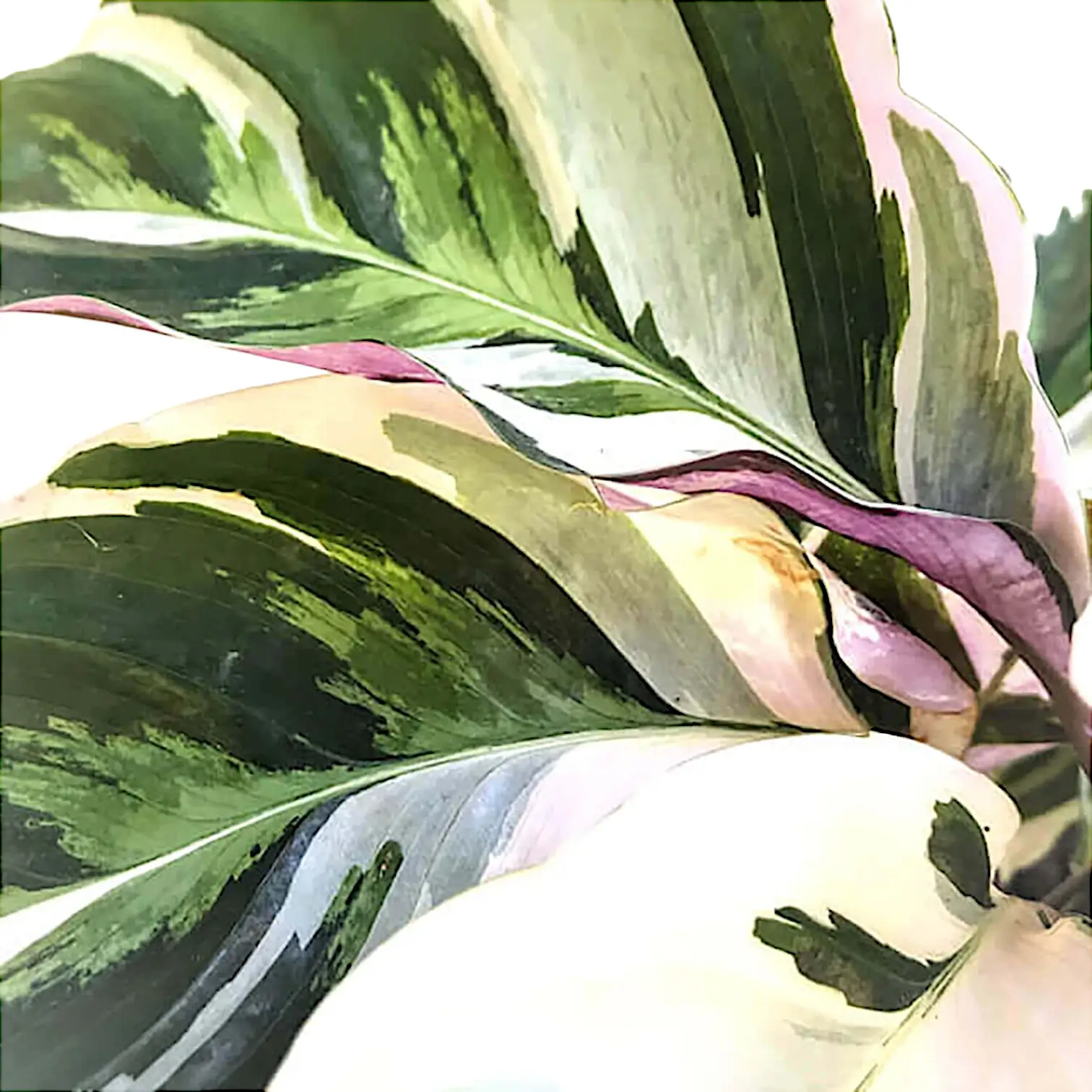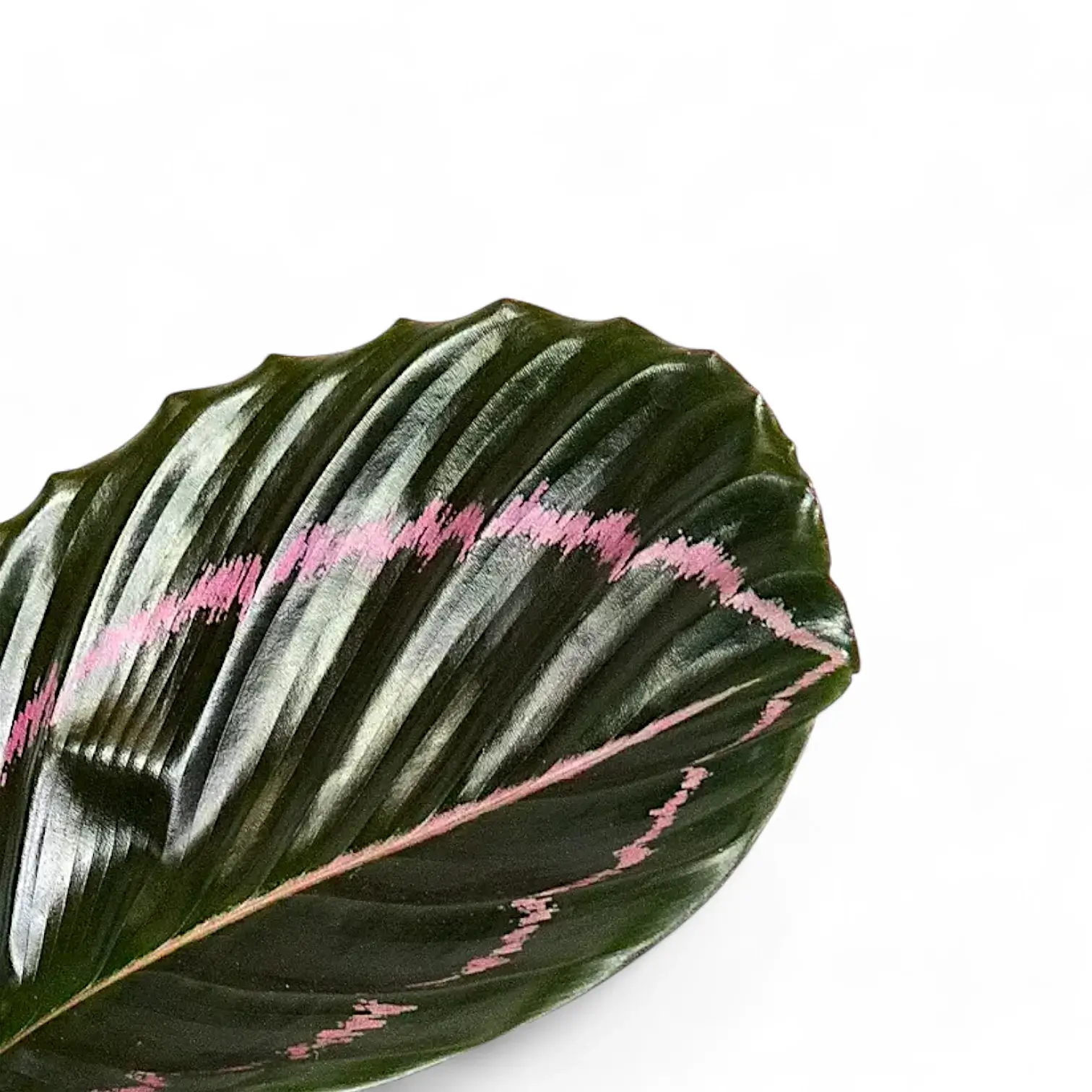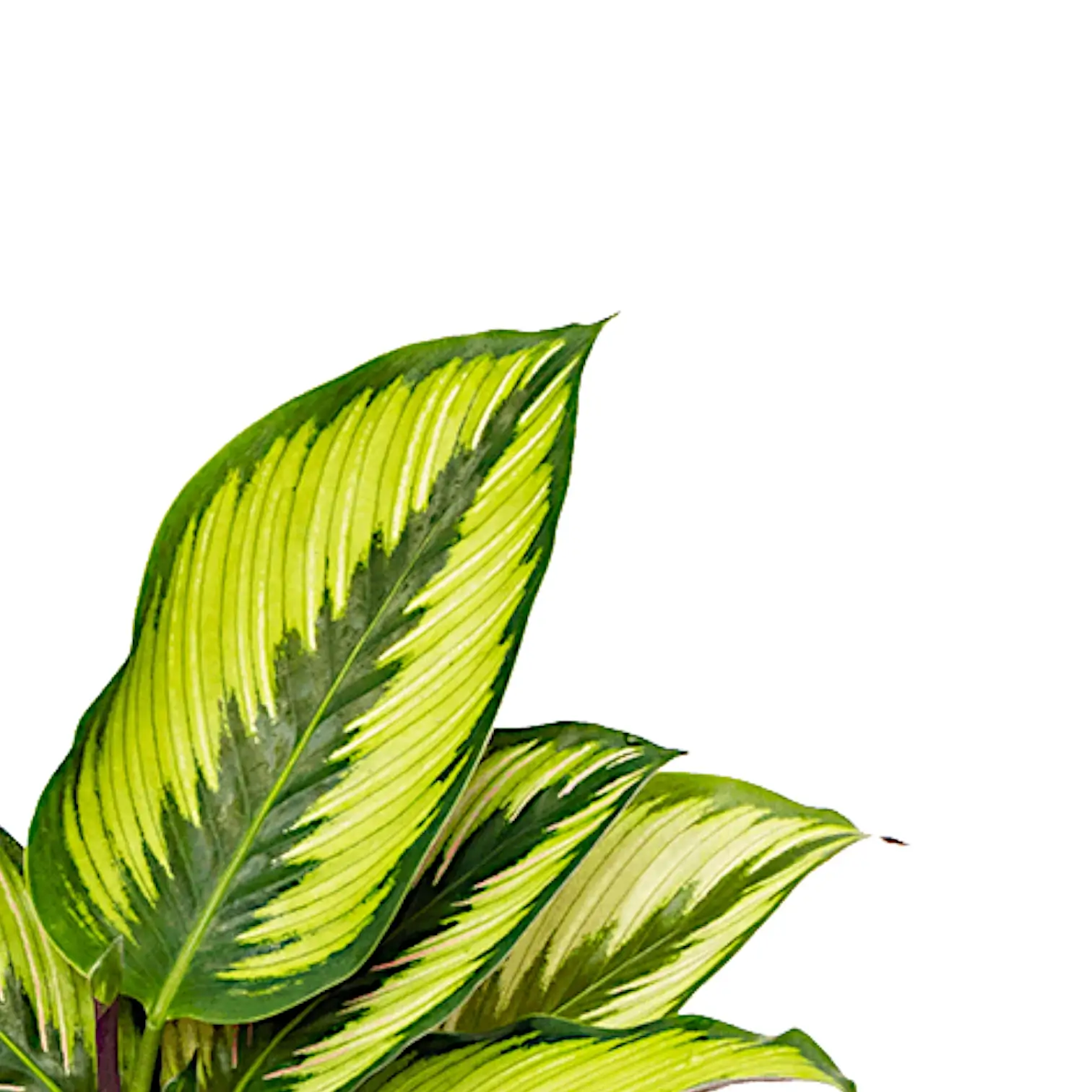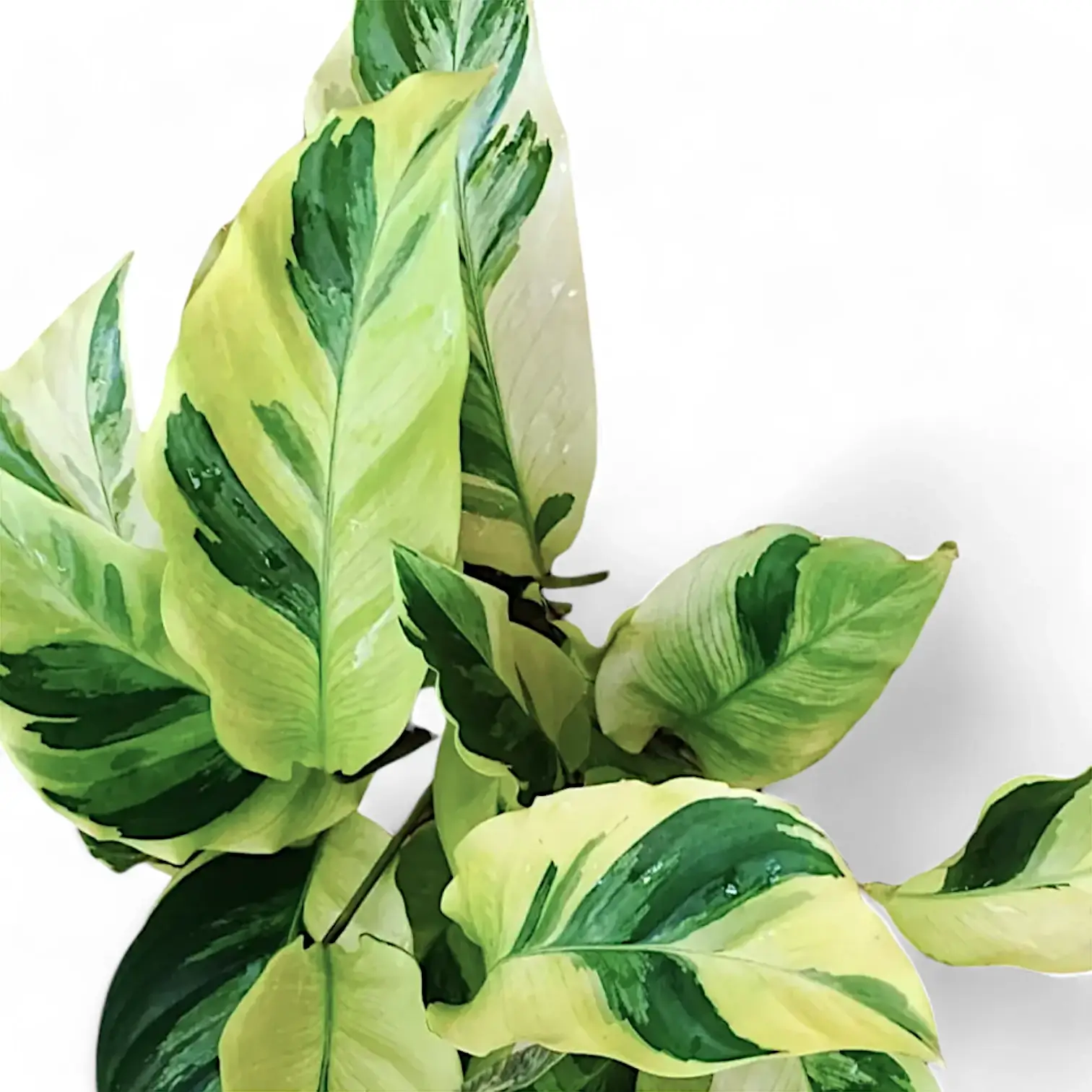
Calathea and Goeppertia Plants
Goeppertia (Calathea) genus plant care and information
Calathea
Calathea is a captivating genus of tropical plants known for their stunning, ornamental foliage. Recently reclassified as Goeppertia, this detail adds an interesting layer to their history but doesn't change the allure that these plants bring. Beloved by plant enthusiasts, Calathea brings a vibrant splash of color and intricate leaf patterns that can transform any indoor space into an exotic retreat. Whether you’re new to indoor plants or a seasoned collector, Calathea stands out for its intricate leaf designs and vibrant presence, offering a unique touch to any space. Often referred to as living works of art, Calathea leaves showcase a variety of mesmerizing designs—from bold stripes to feather-like markings, and even painterly blends of green, silver, purple, and pink. This incredible variety makes Calathea one of the most desirable choices for those looking to enhance their interior decor with lush, striking greenery. It’s no wonder these plants are among the favorites for creating a visually engaging and calming indoor environment. The Goeppertia genus, still commonly called Calathea, includes a diverse range of species and cultivars, each offering its own unique charm. One standout is Calathea orbifolia, which features large, rounded leaves adorned with delicate silvery stripes, prized not only for their beauty but also for their adaptability to indoor conditions. It is a favorite for those seeking a statement plant that exudes elegance. Meanwhile, Calathea lancifolia, also known as the Rattlesnake Plant, delights with its elongated wavy leaves and deep purple undersides—bringing both color and texture into the home. Another popular variety is Calathea roseopicta, recognizable by its dark green leaves highlighted by a vivid pink central stripe. Calathea's popularity also stems from its non-toxic nature, making it safe for homes with pets and children. This feature makes Calathea an accessible and worry-free choice for plant lovers who want to ensure their space is both beautiful and safe for the whole family. The versatility of Calathea makes it an excellent choice for nearly any indoor setting. Its vibrant colors and bold patterns can make a stunning focal point in a room or contribute to a lush, layered indoor garden. Whether you’re aiming to create an impressive display with a single eye-catching plant or building a collection of various species, the diversity within the Goeppertia (Calathea) genus means there’s a perfect plant to suit every style and preference. From the intricately patterned Calathea makoyana, often called the Peacock Plant, to the understated elegance of Calathea orbifolia, these tropical beauties offer something for everyone. With their striking visual appeal and ease of care, Calathea plants are an ideal choice for bringing greenery, natural charm, and a sense of tranquility into your home. Ready to explore the different Calathea varieties and find the perfect one for your home? Let’s dive into their unique qualities and discover what makes these plants so cherished.

On this Page:
Everything You Need to Know About Calathea and Goeppertia Plants
Quick Guide for Those on the Run
Essential Info & Tips
Origins and Genus Information
Learn about the history habitat of Calathea and Goeppertia plants.
Comprehensive Plant Care Guide
Tips on watering, light, soil and much more to keep your Calathea plants thriving.
Troubleshooting Common Calathea Problems
Solutions for issues like leaf curling, browning edges,pests.
FAQs About Calathea Care
Quick answers to the most common questions about Calathea care.
Most Popular Calathea Varieties
Explore the most wanted, best-selling, favourite varieties of our customers
All Our Calathea Varieties
Explore all Calathea plants to see which you are still missing from your collection.

Quick Guide to Calathea and Goeppertia Plants:
-
Genus Name: Goeppertia Nees, before Calathea G.Mey
-
Family: Marantaceae
-
Common Names: Prayer Plant, Peacock Plant, Rattlesnake Plant
-
Type Species: Calathea lutea (Aubl.) Schult. Mant
-
Native Range: Tropical Americas, particularly Brazil
-
Natural Habitat: Understory of tropical rainforests. Grows in shaded, humid conditions with nutrient-rich, well-draining soil. The dense canopy provides indirect light, ideal for Calathea's growth.
-
Plant Type: Herbaceous perennial
-
Foliage: Large, vibrant leaves with intricate patterns
-
Root Structure: Fibrous roots. Repot every 1-2 years to avoid becoming root-bound.
-
Blooming: Rare indoors; blooms in late summer in natural habitats
-
Unique Feature: Leaves fold upwards at night (nyctinasty)
-
Growth Rate: Moderate during warmer months with optimal conditions
-
Size: Grows up to 1 m in height and width, suitable for indoor environments
-
Hardiness: Zones 10-11, ideal for tropical and subtropical climates
-
Toxicity: Non-toxic to pets and humans
Care Requirements:
-
Care Level: Moderate to high maintenance. Requires consistent humidity and careful watering.
-
Ideal Placement: Place in indirect light, like near an east-facing window. Avoid drafts.
-
Temperature: Prefers 18-27°C. Avoid temperatures below 15°C.
-
Humidity: Needs high humidity (above 50%). Use a humidifier if needed.
-
Light: Indirect, low to medium light. Direct sunlight can damage leaves.
-
Water: Keep soil consistently moist but not waterlogged.
-
Soil: Rich, well-draining organic soil.
-
Fertilizing: Feed monthly with diluted, balanced liquid fertilizer.
-
Container: Use pots with multiple drainage holes.
-
Repotting: Repot every 1-2 years, ideally in spring.
-
Pruning: Remove dead or damaged leaves for appearance and health.
-
Leaf Care: Wipe gently with a damp cloth. Avoid leaf shine products.
Common Issues and Special Care:
-
Problems: Brown leaf edges indicate low humidity or poor water quality. Yellowing suggests overwatering.
-
Pests: Prone to spider mites and aphids. Inspect and clean regularly.
-
Fungal Issues: Susceptible to root rot from overwatering and leaf spot in damp, poorly ventilated areas.
-
Propagation: Best propagated by division during repotting.
-
Longevity: Offers long-term decorative value with proper care.
-
Special Care Tips: Use filtered or distilled water to avoid mineral buildup. Maintain high humidity.
-
Tolerances: Not tolerant of direct sunlight, low humidity, or cold temperatures. Prefers a warm, stable environment.

Calathea and Goeppertia PLANTS:
Origins, Botanical Features, History, and Cultural Relevance
Calathea, part of the Marantaceae family, has fascinated plant lovers with its vibrant, patterned leaves and graceful nightly movements. Many species have recently been reclassified into the genus Goeppertia due to genetic research. Despite the name change, these tropical plants continue to captivate both scientists and indoor plant enthusiasts with their beauty, unique leaf movement, and air-purifying qualities.
-
Origins and Natural Habitat of Calathea and Goeppertia PLANTS
Calathea and Goeppertia come from tropical regions of the Americas, especially Brazil. They thrive in humid rainforests, growing under thick canopies with filtered light. These warm, moisture-rich conditions make them perfect as houseplants, though recreating this environment at home can be challenging. To help them thrive indoors, it's important to provide high humidity and well-drained soil.
-
Historical Significance and Early Discoveries of Calathea
European naturalists first documented Calathea and Goeppertia in the 18th and 19th centuries during expeditions to South America. Their vivid colors and dramatic leaf patterns stood out compared to European flora, making them highly valued in botanical collections and contributing greatly to the understanding of tropical biodiversity. These early discoveries laid the foundation for Calathea's popularity as ornamental plants.
-
Cultural and Symbolic Significance
Calathea and Goeppertia symbolize vitality, resilience, and natural beauty. Their nightly leaf-folding, which looks like hands in prayer, inspires spiritual mindfulness. This movement, called nyctinasty, adds to their symbolism of renewal and hope. Their striking leaf designs have influenced art, including botanical illustrations, textiles, and fashion. Calathea's natural beauty and calming presence make them a favorite for creating a tranquil indoor space.
-
Advances in Botanical Research and Reclassification
Recent advances in plant genetics, especially DNA sequencing, have led to the reclassification of many Calathea species as Goeppertia. This has clarified evolutionary relationships within the Marantaceae family, helping distinguish between closely related species more accurately. The reclassification reflects ongoing progress in understanding plant taxonomy and genetics.
-
Botanical Features and Ecology
Calathea and Goeppertia Plants are known for their broad, strikingly patterned leaves, with colors ranging from deep green to purple and silver. Their leaf movement at night—nyctinasty—helps reduce moisture loss and protect against herbivores and heavy rain. These plants play an important role in rainforest ecosystems, contributing to soil health and providing shelter for small animals. Their ability to thrive in low-light environments makes them great indoor plants for adding a lush, tropical feel to any space.
-
Artistic and Practical Uses
Calathea's intricate leaf patterns have inspired botanical art and textile designs around the world. In their native regions, their large leaves have practical uses, such as wrapping food, constructing shelters, and making traditional items. More recently, species like Calathea lutea have been used in sustainable packaging as alternatives to plastics. The versatility of Calathea goes beyond their ornamental value, showing their importance in both traditional and modern uses
-
Economic Importance
The economic value of Calathea and Goeppertia comes from their popularity as ornamental houseplants. Their stunning foliage makes them favorites for interior decoration, with species like Calathea orbifolia and Goeppertia veitchiana being particularly sought after. Additionally, some species have practical uses, like providing natural food wrapping or roofing materials. The demand for these plants in the horticultural market continues to grow because of their aesthetic appeal and versatility.
-
Conservation and Genetic Diversity
The reclassification of many Calathea species has highlighted their genetic diversity and the need for conservation. Habitat loss due to deforestation in Brazil poses significant threats to these plants. Preserving them is crucial for maintaining the ecological balance and biodiversity of tropical rainforests. Conservation efforts focus on protecting their natural habitat and ensuring the survival of these unique tropical plants for future generations.
-
Folklore and Cultural Stories
In native cultures, Calathea is seen as a symbol of prosperity and protection. Their nightly "prayer" movement is believed to ward off negative energy, making them cherished as symbols of hope and good fortune. Many people believe that keeping a Calathea plant at home brings positivity and good luck, adding to their popularity as an indoor plant that enhances well-being.
-
Interesting Facts and Trivia
-
Nyctinasty: The nightly leaf movement is driven by a special joint called the pulvinus, which reacts to changes in light and humidity.
-
Genus Name: The genus Goeppertia was named after Heinrich Goeppert, a 19th-century botanist known for his contributions to plant science.
-
Pet-Friendly: Calathea plants are non-toxic and relatively pet-friendly, making them suitable for households with pets.
-
Camouflage: The intricate leaf patterns may serve as camouflage, helping the plant blend into the dappled light of its native rainforest understory.
-
Slow Growth: Many Calathea species are slow-growing, which makes them perfect for indoor environments where space is limited
Calathea and Goeppertia plants embody the beauty of tropical biodiversity and cultural heritage. From their vibrant leaf patterns to their fascinating nightly movements, these plants connect us to the rich ecosystems of the American tropics and the cultural traditions of the people who value them. Whether in the rainforest or decorating our homes, Calathea and Goeppertia continue to inspire wonder and appreciation for the natural world. They offer a unique blend of beauty, adaptability, and cultural significance, making them a wonderful addition to any indoor space.

The Ultimate Care Guide for
Calathea and Goeppertia Plants
Calathea and Goeppertia plants, known for their stunning, vibrant foliage, are popular indoor houseplants. To help these tropical beauties thrive, it's essential to recreate their natural rainforest environment, ensuring proper light, humidity, and care. This guide covers all you need to know to care for these beautiful plants.
With proper care, these plants will reward you with their stunning, intricate leaf patterns, bringing a beautiful, rainforest-like vibe to your home.
Follow these care tips and your Calathea or Goeppertia will not only survive but flourish, becoming a vibrant centerpiece in your home!
Humidity Requirements for Healthy Growth:
-
Humidity Level
Aim for at least 50%, but 60–70% is ideal. Consider using a hygrometer to measure humidity levels effectively.
-
Increasing Humidity
Use a humidifier, group plants together, or place the pot on a tray with water and pebbles (keeping the pot elevated above the water).
-
Misting
Regular misting helps but is less effective than other methods due to its short-term impact. A humidifier provides more sustained humidity, which is more beneficial for the plant.

The Ultimate Troubleshooting Guide
for Calathea and Goeppertia:
Common Issues and Solutions
Calathea and Goeppertia plants are admired for their stunning foliage and intricate patterns, but they can be tricky to care for. This guide offers practical solutions for common issues, so you can keep your Calathea and Goeppertia plants healthy and thriving. Whether you’re dealing with drooping leaves or brown tips, these tips will help you solve problems effectively.
Pests (Spider Mites, Mealybugs, Aphids, Scale Insects):
Issue: Calatheas and Goeppertias are prone to pests, especially in low humidity. Common pests include spider mites, mealybugs, aphids, and scale insects, which can cause discoloration, spots, curling, and general decline in plant health.
Solutions:
-
Inspection and Isolation: Regularly inspect leaves and stems for signs of pests like webbing (spider mites), fluffy white clusters (mealybugs), sticky residue (aphids), or hard brown bumps (scale insects). Isolate affected plants immediately to prevent pests from spreading.
-
Manual Removal: Wipe off pests with a damp cloth. For larger pests like mealybugs, use a cotton swab dipped in rubbing alcohol. Check every leaf to make sure all pests are removed.
-
Insecticidal Soap or Neem Oil: Apply insecticidal soap or neem oil, making sure to cover both sides of the leaves and stems. Reapply every 7-10 days until the pests are gone. Neem oil also helps prevent future infestations.
-
Humidity Control: Increase humidity to 50-60%, as dry conditions attract spider mites. Using a humidifier can help maintain the correct levels.
-
Preventive Care: Wipe leaves with diluted neem oil every few weeks as a preventive measure. Keep the area clean by removing fallen leaves and maintaining good air circulation. Avoid overcrowding plants to prevent pest issues, and perform regular checks to catch infestations early.

Frequently Asked Questions
About Calathea and Goeppertia Care and Maintenance
1. How Much Light Does a Calathea Need?
Calathea plants love bright, indirect light. This means placing them in a spot where they receive good natural light without the sun's rays directly hitting the leaves. A great spot is near an east or north-facing window, where they get gentle morning light. Avoid placing them where they get full sun—this can cause leaf burn or fading. Artificial grow lights can be used if natural light is limited.
2. What’s the Best Way to Water Calathea?
Calathea and Goeppertia plants are sensitive to water quality, so using distilled water, rainwater, or filtered tap water is best. Keep the soil consistently moist, but not soggy—allow the top 2-3 cm of soil to dry out before rewatering. Hard or chemically-treated tap water can cause browning on the leaves, so make sure to avoid this type of water whenever possible.
Tip: If using tap water, leave it out overnight to allow the chemicals like chlorine to dissipate.
3. What Kind of Soil Do They Prefer?
Calatheas love a soil mix that is light, airy, and well-draining. A blend like African violet potting soil or a mix of peat and perlite works wonders. It keeps the moisture level right while ensuring excess water doesn’t stay around to rot the roots.
Simple Mix Recipe: Use two parts peat moss and one part perlite.
4. What Temperatures and Humidity Levels Are Ideal?
-
Temperature: These tropical beauties love it warm—between 18-26°C is perfect. Keep them away from drafts and sudden temperature changes, as anything below 15°C can stress them.
-
Humidity: High humidity is a must—aim for 60% or more. A humidifier, pebble tray, or regular misting can help. Grouping plants together also boosts humidity.
Note: In dry climates or during winter, running a humidifier can make a big difference in keeping those leaves lush.
5. Why Are My Calathea Leaves Curling?
If your Calathea leaves are curling, it’s a sign that something’s not quite right. The common causes are low humidity, too much sunlight, or inconsistent watering. To fix this:
-
Increase humidity around the plant.
-
Avoid direct sunlight—bright, indirect light is best.
-
Water consistently, ensuring the soil stays slightly moist but never waterlogged.
6. What Causes Brown Leaf Tips ON CALATHEA?
Brown tips are usually a sign of low humidity or poor water quality. Increasing the humidity with a humidifier or placing the plant on a tray of wet pebbles can help. Also, make sure you're using pure or filtered water, as chemicals in tap water can cause the tips to dry out and turn brown.
7. How Should I Fertilize Calathea?
Fertilize once a month during spring, summer, and fall with a balanced houseplant fertilizer at half-strength. Avoid fertilizing during the winter months, as the plant’s growth naturally slows down then.
Tip: Over-fertilizing can lead to burnt roots or discolored leaves, so stick to a light touch!
8. How Often Should Calathea Be Repotted?
Calathea doesn’t need frequent repotting—every 2-3 years is usually enough, or whenever you see the roots peeking out from the pot’s bottom. Go up just one pot size when repotting to avoid overwhelming the plant. Use fresh, airy soil during repotting to keep the roots happy.
9. What Pests Should I Watch Out For?
Calathea plants can attract common indoor pests like spider mites, mealybugs, and aphids. Keep an eye on the undersides of leaves for any signs of these critters. Insecticidal soap or neem oil works well for treating infestations, and maintaining high humidity helps deter many pests.
Tip: Wipe the leaves regularly to keep them clean and make it harder for pests to settle in.
10. Can I Propagate Calathea?
Propagation is typically done by division and works best in spring or summer. If your Calathea has grown large enough, gently separate the root clumps and repot each one. Keep the divisions in a humid environment until they establish themselves—covering them with a plastic tent or misting frequently can help.
Note: Division changes the full appearance of the plant, so it’s a good idea only if you’re willing to have multiple smaller plants instead of one large one.
11. Why Are the Leaves Turning Yellow?
Yellow leaves can indicate overwatering, low light, or humidity issues. Make sure you’re letting the top layer of soil dry before watering again, providing indirect light, and maintaining high humidity. Trim away the yellow leaves to help the plant focus its energy on healthy growth.
12. How Should I Care for Calathea During Winter?
In winter, Calatheas naturally slow down their growth. If light levels and temperatures remain consistent, there is no need to change the usual watering and fertilizing schedule. However, if the environment is cooler or less bright, reduce watering slightly but don’t let the soil dry out completely. Withhold fertilizer during the dormant phase if growth visibly slows.
Tip: Move the plant to a slightly sunnier spot as winter daylight hours get shorter, but continue to avoid direct sun.
13. Do Calathea Plants Flower Indoors?
Although Calathea can flower, they are mostly appreciated for their stunning leaves. Varieties like Calathea crocata do bloom indoors, but the flowers are usually less showy than the striking leaf patterns.
14. Are Calathea and Goeppertia plants Safe for Pets?
Yes, Calathea and Goeppertia are non-toxic to both pets and children, making them safe for homes with animals or little ones.
15. Why Are My Calathea's Leaf Patterns Fading?
If the leaf patterns start to fade, it’s usually a sign of too much light. Move your Calathea to a shadier spot where it receives filtered light—direct sunlight can bleach out the vibrant colors. Keeping them in moderate to low indirect light will help retain their signature striking patterns.
More Tips for Caring for Your Calathea:
Explore our Extended Calathea FAQ Care Guide for in-depth answers and actionable tips—covering everything from care essentials to solving common problems. Visit now and ensure your plant stays vibrant and healthy!
Explore Calathea and GoeppertiA
Diverse Species and Varieties
Calathea and Goeppertia varieties are known for their stunning foliage and unique leaf patterns, making them perfect for any indoor space. Discover the broad, silvery-green leaves of Calathea orbifolia or the soft, velvety texture of Goeppertia rufibarba. Each plant has its own story and special care needs that are easy to follow. Browse our collection to learn more, find your favorite, and bring a touch of nature into your home.
Here you can explore our Calathea and Goeppertia varieties:
Each species and variety comes with its own detailed description and care guide, providing everything you need to grow and enjoy these stunning plants.
All available Calathea and Goeppertia plants can be purchased directly from our Calathea and Goeppertia Collection in the shop.
Most Popular Calathea Varieties:
Goeppertia (Calathea) orbifolia
Goeppertia orbifolia, also known as Calathea orbifolia, is a stunning houseplant with broad, silver-striped green leaves and rounded foliage. Its large leaves, up to 30 cm wide, feature bold patterns that make it a standout addition to any home.
This Calathea variety thrives in bright, indirect light and high humidity. Proper care includes keeping the soil consistently moist but not waterlogged, with occasional misting to maintain humidity.
Goeppertia orbifolia is a great choice for beginners and experienced plant lovers alike, bringing lush, tropical greenery to your indoor space without demanding high maintenance. Add Goeppertia orbifolia to your collection and transform your home with its vibrant beauty!
Goeppertia lietzei 'White Fusion'
Goeppertia lietzei 'White Fusion', also known as Calathea 'White Fusion', is an eye-catching houseplant prized for its unique foliage. The leaves are a beautiful mix of green, white, and light purple, creating a marbled effect that stands out in any collection. The striking contrast and variegated pattern of its foliage make it an exceptional addition to any home.
This Calathea variety thrives in bright, indirect light and requires high humidity to maintain its vibrant colors. Keeping the soil evenly moist but avoiding waterlogging is key to its health, and regular misting helps boost the humidity level that this plant loves.
Goeppertia 'White Fusion' is ideal for those who want to add a visually distinct and lush tropical plant to their space. Though it requires a bit more attention than some other houseplants, the reward is well worth it, as its unique colors and patterns bring a touch of the extraordinary to any room.
Goeppertia (Calathea) roseopicta 'Dottie'
Goeppertia roseopicta 'Dottie', commonly known as Calathea 'Dottie', is a truly captivating plant with dark, almost black leaves highlighted by vivid pink veining and accents. The striking pink lines create a spiral effect in the center, making it appear as though the leaves are outlined by a delicate brushstroke. This dramatic color contrast brings a sense of mystery and elegance to any room, making 'Dottie' a favorite among collectors.
Unlike many other Calathea varieties, 'Dottie' is especially appreciated for its compact growth habit, which makes it suitable for smaller spaces or as an accent piece on shelves or desks. It thrives best in bright, indirect light, where the pink hues can truly pop, and prefers consistently moist soil that is never soggy. Humidity is key for this plant, so placing it in a kitchen or bathroom can often help meet its needs naturally, or using a pebble tray can also maintain ideal moisture levels.
Goeppertia 'Dottie' is ideal for plant enthusiasts looking for something dramatic and unique. Though it needs a bit of extra care with humidity and regular watering, its bold color palette makes it a rewarding choice, adding a striking, almost gothic vibe to your indoor plant collection.
Goeppertia (Calathea) ornata 'Beauty Star'
Goeppertia ornata 'Beauty Star', also known as Calathea 'Beauty Star', is a stunning houseplant prized for its elegant, lance-shaped leaves. The dark green foliage is adorned with delicate pale pink and white pinstripes that radiate outward, giving the leaves an intricate, almost painted appearance. The leaves have a glossy finish, which catches the light beautifully and enhances the plant's refined aesthetic. Unlike other Calatheas, 'Beauty Star' grows in a more upright, graceful form, making it ideal for tabletops or floor displays.
This variety does well in bright, indirect light, where its colorful patterns can shine without the risk of scorching. 'Beauty Star' prefers consistently moist soil, but be sure to avoid waterlogging. Maintaining high humidity is also essential to keep its leaves healthy and prevent browning. A humidifier or frequent misting will help meet its needs, especially in drier environments.
Goeppertia 'Beauty Star' is perfect for those looking to bring a touch of refined elegance to their indoor space. With its delicate striping and striking foliage, it stands out as a sophisticated, low-maintenance option that adds a touch of the extraordinary to any collection.
Goeppertia (Calathea) lietzei 'Yellow Fusion'
Goeppertia lietzei 'Yellow Fusion', also known as Calathea 'Yellow Fusion', is an exceptional houseplant cherished for its vibrant, variegated leaves. The foliage is a striking combination of bright green, soft yellow, and cream, often with hints of light green marbling, creating a beautifully blended effect that feels almost tropical. The distinctive yellow tones give this plant a sunny and uplifting presence, perfect for brightening up any corner of your home.
Unlike other Calatheas, 'Yellow Fusion' stands out for its cheerful color palette and slightly more compact growth, making it ideal for shelves or small plant stands. It flourishes in bright, indirect light, where its colors can shine without fading, and it needs evenly moist soil to stay healthy. This plant loves a humid environment, so a pebble tray or regular misting will help it thrive, especially during dry months.
Goeppertia 'Yellow Fusion' is an excellent choice for plant enthusiasts seeking a vibrant and unique statement piece. Its radiant colors bring a sense of freshness and liveliness to indoor spaces, making it a rewarding addition to any plant collection.
